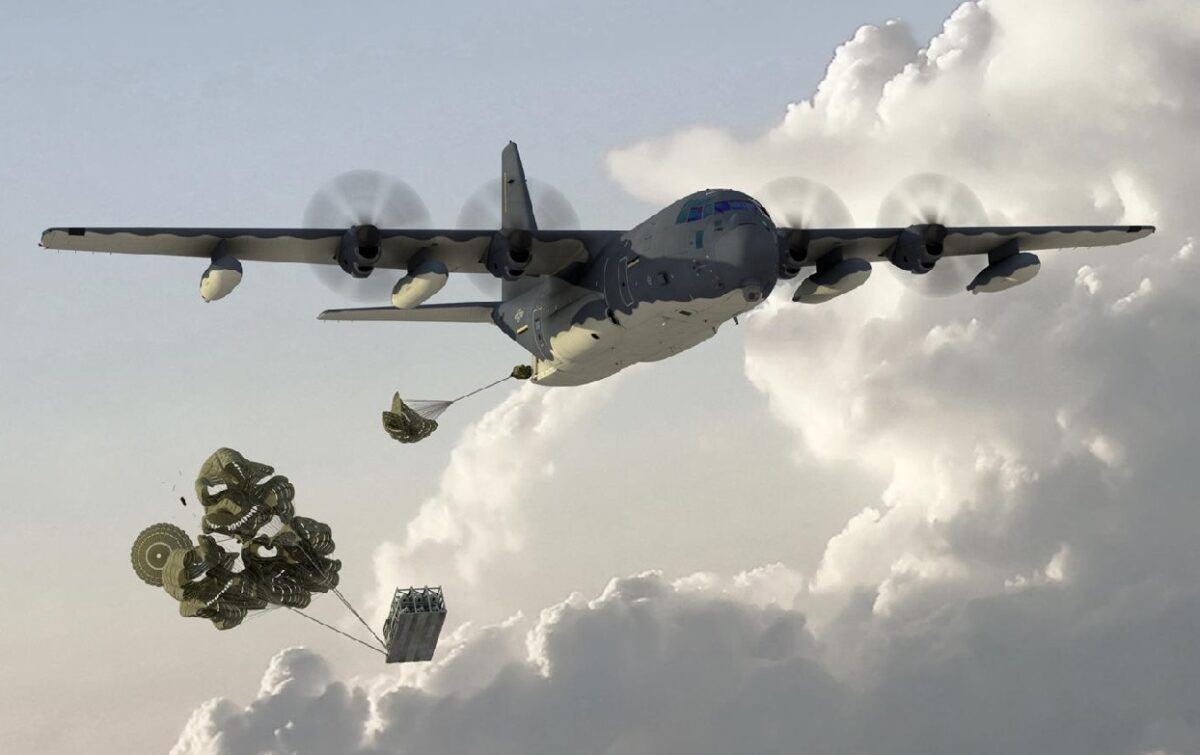Rapid Dragon Is Here: In December, one of the U.S. Air Force’s most promising programs reached a major milestone when a cruise missile launched from a transport aircraft destroyed a target over the Gulf of Mexico.
The Palletized Weapon System concept seeks to turn benign transport aircraft into deadly platforms, thereby increasing the Air Force’s deterrence and confusing potential adversaries.
Rapid Dragon
The test involved an MC-130J Commando II aircraft assigned to the Air Force Special Operations Command that was flying over the Gulf of Mexico when it received new targeting data.
The crew inserted the data into the battle management system of the cruise missile flight test vehicle—the first time the battle management system of a live cruise missile receives new targeting data inflight—and then airdropped the cruise missile in a pallet with a parachute.
Upon release, the cruise missile deployed its wings and tail, achieved aerodynamic control, ignited its engine, performed a powered pull-up maneuver, and proceeded toward its newly assigned target. The cruise missile successfully destroyed its target upon impact.
“This type of experimentation campaign, that address capability gaps and demonstrates transformative efforts, helps us shape future requirements and reduces timeline to fielding. This approach ultimately enables a rapid fielding alternative to traditional lengthy acquisition timelines,” Major General Heather Pringle, the commanding officer of the Air Force Research Laboratory, said in a press release.
For the project team, the next step is to replicate their success from a C-17 Globemaster III aircraft. That test is scheduled to take place sometime in early 2022. The Air Force Research Laboratory has highlighted the program’s “aircraft agnostic capabilities,” that aim to have the cruise missile certified in a number of different aircraft instead of being restricted to a particular platform.
“Rapid Dragon is a prime example of a government/industry partnership that embraces this acceleration mindset, building a community of subject matter experts and executing an aggressive, but well-thought-out, experimentation campaign,” Dr. Dean Evans, the program manager of SDPE’s Rapid Dragon, stated.
“Rapid Dragon was able to accelerate development by building a broad and strong team. We were committed to a ’test often/learn-fast’ culture, dedicated to experimenting frequently and taking calculated risks. In addition to the MAJCOMs and Air Staff, the Rapid Dragon team included the Developmental Test (DT) and Operational Test (OT) communities, the aircraft and weapons Program Offices, and the mission planners. This collaboration from the onset streamlined the process and accelerated development, involving groups from the program inception that are not normally included at the very early stages, and that has made all the difference,” Evans added.
AC-130 and MC-130
The Air Force Special Operations Command is looking for ways to keep its two main fixed-wing aircraft relevant in a near-peer conflict with China or Russia.
Both aircraft have been used to operating in air superiority environments. However, Beijing and Moscow both possess potent aircraft fleets and anti-aircraft capabilities that would restrict the AC-130 gunship and MC-130 transport from operating freely.

Airmen and Riggers with the 1st Special Operations Squadron Logistics Readiness Squadron load a Rapid Dragon Palletized Weapon System aboard an MC-130J Commando II at Hurlburt Field, Florida, Dec. 13, 2021. The Rapid Dragon Program demonstrates the ability to employ weapons using standard airdrop procedures from cargo aircraft anytime and anywhere. (U.S. Air Force photo by Staff Sgt. Brandon Esau)

A U.S. Army Humvee sits on the cargo bay of a C-17 Globemaster III, assigned to the 437th Airlift Wing, as part of Exercise Dragon Lifeline August 8, 2019, above South Carolina. The deployment readiness exercise combined the capabilities of service members from Fort Bragg, N.C., Joint Base Charleston, S.C., and Joint Base Langley-Eustis, Va., focused on the rapid deployment of equipment, vehicles and personnel. Participants shared knowledge and tested their efficiency in moving assets by air, land, rail and sea during the training event. The annual exercise is just one of the critical readiness exercises the DOD conducts to maintain a lethal and ready force. (U.S. Air Force photo by Staff Sgt. Tenley Long)

Airmen and Riggers with the 1st Special Operations Squadron Logistics Readiness Squadron load a Rapid Dragon Palletized Weapon System aboard an MC-130J Commando II at Hurlburt Field, Florida, Dec. 13, 2021. The Rapid Dragon Program demonstrates the ability to employ weapons using standard airdrop procedures from cargo aircraft anytime and anywhere. (U.S. Air Force photo by Staff Sgt. Brandon Esau)

Image Credit: Lockheed Martin.

Image: Creative Commons.
So, the Pentagon has been developing stand-off munitions, including cruise missiles, that these aircraft can carry and deploy from a distance that would allow them to avoid any incoming missiles.
Now 1945s National Security Columnist, Stavros Atlamazoglou is a defense journalist and military expert specializing in special operations, a Hellenic Army veteran (national service with the 575th Marine Battalion and Army HQ), and a Johns Hopkins University graduate.

